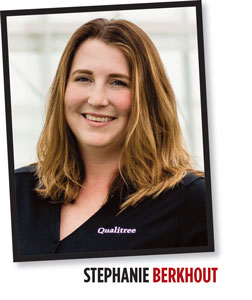9/1/2020
Water You Gonna Do About It?
Stephanie Saccomano

(Editor’s note: We’re happy to welcome Stephanie to the GrowerTalks contributing staff! Not only was she lucky enough to be this year’s Young Grower Award winner, but we thought she’d make a pretty good columnist, too.—JZ)
There’s so much vulnerability behind the phrase, “I don’t know.” Being somewhat of a newcomer to the industry (less than five years), it’s no surprise that this is part of my sound board and uttered on a regular basis. It’s intimidating at times. Nobody particularly enjoys admitting a weakness or to sound potentially incapable. I was the kind of kid in school who cringed at a B on my report card. However, what I’ve come to learn, accept and embrace is that if you stop looking for things you don’t know, you’ll get either bored or complacent. Neither are enjoyable for you or fruitful for business.
What struck me and helped me stomach this were some of the leaders in my life who I discovered were also frequent fliers of this phrase. When I first stepped onto the nursery, concrete was pouring for Phase 1 of the new greenhouse and work was underway for a reservoir system. Three basins: The first was acid-adjusted water straight from the well, the second a collection of rainwater from the greenhouse roof, and the third a large capture for used fertigation from new outdoor fields and indoor flood floors. What wasn’t anticipated was how quickly we would need to research and implement water treatment and filtration for the reservoir—weeds, algae and suspected pathogens quickly encroached!
Ozone, UV light, disinfectant inputs, filtration systems … many options were considered when trying to find the right fit to plug in to our setup. What may work fantastically for one operation may not be the best fit for others. We stewed while our reservoir did the same. Eventually, we took a step and installed an electrochemically activated water (ECA) unit to direct inject. There were many “I don’t knows” while we navigated this new system, but we knocked them out together with the help of the supplier. Our lines released all sorts of fun junk, sprinklers were clogged, subsequently unclogged and we carefully measured the end of the line to ensure chlorine PPM was safe. Things were looking up as we noticed trays, ground cloth and plants becoming cleaner.
However! This still did not remedy the bowls of soup that were our basins. It would take a behemoth shot of ECA to even dent this volume of water and the ECA injection wasn’t rigged to inject for basin fill from our well. We continued diving in (literally and metaphorically) to research a proactive solution. A flaw was determined: our water was too still. There was no recirculation, no oxygenation and as such our dissolved oxygen (DO) was low.
We implemented a fountain system around the perimeter of each basin, physically oxygenating the water. A circulation system was installed as well, cycling and metering the water, and even readjusting for pH along the way if necessary. DO levels climbed and we started seeing some improvement in our basin soup.
In the meantime, each basin has been getting drained, scrubbed and refilled. Hopefully, a process that won’t need doing should our plans prove effective. (You can check out Qualitree’s quest for a healthy reservoir through our social media posts tagged with #JourneytoPondHealth.)
We were a little uneasy showing our “H2-woes” to the world, but from it we actually picked up more valuable advice from those who’ve been in our shoes. We may not have it completely nailed down yet, but there are many tools available to test and combine until we get it right. What’s next on deck for evaluating for integration? Fish, pond plants, ultrasonic units ...
Yes, there’s vulnerability behind “I don’t know,” but there’s also incredible strength and opportunity in admitting that, and adding, “... but I’ll keep trying to get the answers!” GT
Stephanie Saccomano is Indoor Spaces Lead Grower for Qualitree Propagators in Rosedale, British Columbia, Canada.